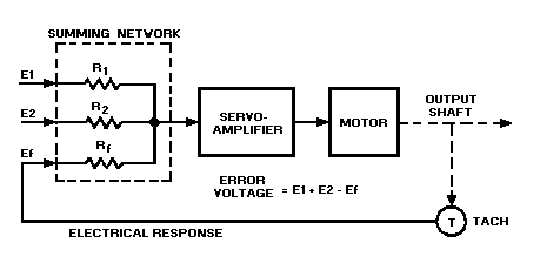2-19
Summing Networks
Summing networks, as we mentioned earlier, are used as error detectors in servo applications where
the servo output must be proportional to the algebraic sum of two or more inputs. A typical circuit is
shown in figure 2-13.
Figure 2-13.—Summing network as an error detector.
As in the case of potentiometers, the networks may use either ac or dc voltage, with the phase or
polarity of the input voltage determining whether the signals are additive or subtractive. Refer to figure 2-
13. If two input signals E1 and E
2
are applied to the network, the network will provide an error voltage
output that is proportional to the algebraic sum of the two signals. The servo motor drives the load and
also a tachometer that supplies feedback voltage to resistor Rf. Resistor Rf nulls the error signal.
In some installations, the servo motor may position the wiper arm of a potentiometer instead of
driving a tachometer to supply the feedback voltage.
E-Transformers
The E-transformer is a type of magnetic unit that is used as an error detector in systems in which the
load is not required to move through large angles.
In the basic E-transformer shown in figure 2-14, an ac voltage is applied to the primary coil (2)
located on the center leg of the laminated, E-shaped core. Two secondary coils (1 and 3) are wound
series-opposing on the outer poles of the core. The magnetic coupling between the primary (coil 2) and
the two secondaries varies with the position of the armature. The armature can be physically moved left or
right in the magnetic circuit by mechanical linkage to the load. This changes the reluctance between either
pole and the armature.

